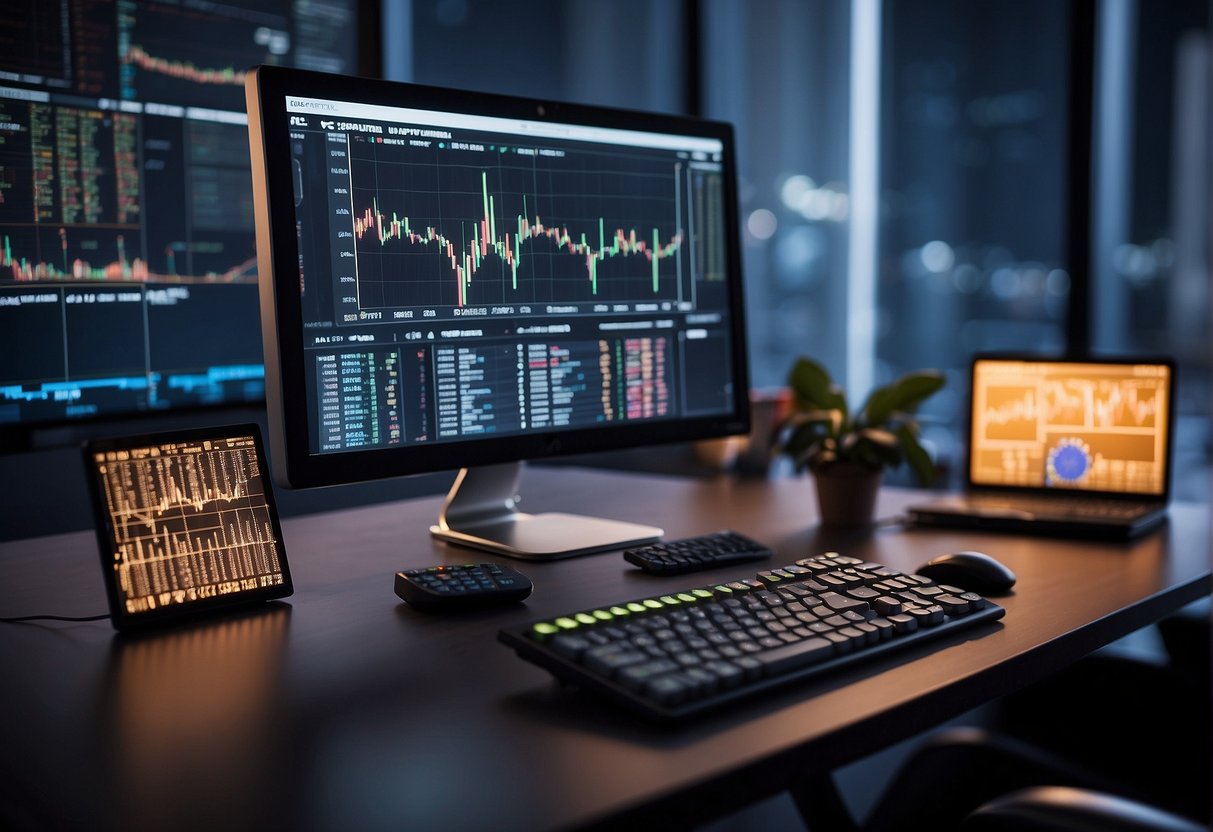
Market
By Mahesh Kashyap
Think of an AI Stock Trading Assistant as your savvy partner in the fast-paced world of stock trading. Armed with cutting-edge algorithms, it dives into the vast sea of market data, identifying patterns and opportunities with remarkable speed and precision. This digital ally doesn't just observe; it executes trades, combining efficiency with a level of accuracy that's truly impressive. For traders navigating the complex landscape of the stock market, this assistant becomes an indispensable tool, offering a powerful combination of analysis and action to help you stay ahead of the game.

AI algorithms have truly transformed the trading arena, offering a fresh perspective with their ability to analyze data in real-time and deliver predictive insights. Imagine having a crystal ball that not only reads the present but also predicts the future. That's what these algorithms do. They sift through mountains of data, picking up on technical indicators and historical price movements to spot where the next big opportunity might lie.
At the heart of this revolution is the use of neural networks, a sophisticated form of machine learning. These networks mimic the human brain's ability to learn from experience, allowing the software to refine its decision-making skills continually. It's like having a trader that gets smarter day by day, learning from the market's twists and turns.
Here's what these AI-powered assistants excel at:

Machine learning stands as the powerhouse behind an AI Stock Trading Assistant, fundamentally transforming how stock analysis is conducted. Picture this: a system that not only learns from the data it's fed but also evolves with each cycle of information it processes. This continuous loop of learning and adapting allows machine learning models to sharpen their accuracy over time, much like a skilled craftsman refining their art.
When it comes to stock analysis, machine learning is akin to having a supercomputer at your disposal. It can digest and analyze vast amounts of data—far beyond human capacity—to evaluate securities and decipher market trends. This capability is not just about handling data; it's about uncovering insights that can guide trading decisions.
The advantages of machine learning in this arena are clear and compelling:
Choosing the right AI stock trading software is a bit like picking out the perfect smartphone. You want something that fits your needs, is easy to use, and won't let you down when you need it most. Here's a simple guide to what you should keep an eye out for an AI stock trading software features:
Technical analysis is pretty much the bread and butter of trading with AI. It's how the software helps you make sense of market trends and patterns to predict where things might be heading. When you're looking at your options, see how well the software can do this analysis. It's like choosing a detective based on how good they are at solving mysteries.

First up, you've got to make sure the assistant plays nice with your brokerage account. This means it should connect without a hitch, letting you keep an eye on real-time data and make trades without skipping a beat. It's important to check that it's compatible with the big-name brokerages and has solid security to keep your financial info safe.
The way you interact with the assistant – its user interface – is super important. You want something that's straightforward and clear, so you're not wasting time trying to figure out where everything is. It should help you keep track of your investments without any headaches. A quick look at what other users have to say can give you a good idea of how easy it is to use for your daily trading.
Every trader has their own way of doing things, so having the ability to customize the assistant to fit your style is crucial. Whether it's setting up alerts that matter to you, crafting unique trading strategies, or adjusting on the fly to market changes, these features let you make the assistant truly yours. And don't forget about backtesting – being able to test your strategies with past data is a huge plus, helping you refine your approach before putting it into action.
By paying close attention to these areas, you can smartly pick an AI stock trading assistant that not only meets your needs but becomes an indispensable part of your trading toolkit.

Navigating the stock market's ups and downs requires sharp analysis and timely information. That's where AI stock trading assistants come into play, leveraging the latest tech to give investors the edge they need. These tools are all about making sense of the market in real time and predicting what's next, helping you manage your portfolio like a pro.
Having the latest market data at your fingertips is key to making smart decisions quickly. Gone are the days of waiting for the evening news to see how the market performed. Today's AI assistants feed you live data, so you're always in the know. This means you can react to changes as they happen, potentially boosting your investment results.
Spotting trends is crucial in trading. It's about seeing where the market is heading, whether in the short term or down the road. AI excels at digging through the data, spotting both big-picture trends and the finer details. It uses past performance and cutting-edge algorithms to highlight opportunities or warn you of potential downturns. Understanding these trends gives you a solid base to act on, whether you're spotting a chance to buy or a signal to sell.
AI trading assistants do more than just monitor the market; they offer predictions that can be gold for managing your investments. By crunching massive amounts of data, they can forecast market movements with impressive accuracy. This foresight allows you to tweak your portfolio in advance, reducing risks and aiming for better returns.
For anyone looking to succeed in the stock market, AI trading assistants provide a comprehensive toolkit. They blend live data, trend analysis, and predictive insights to offer a modern approach to investment strategy. Whether you're just starting out or you're a seasoned investor, these platforms can help you navigate the market's complexities and work towards your financial goals.
When it comes to navigating the stock market, investors are always on the lookout for that extra edge. AI stock trading assistants have become go-to resources for those looking to make informed, efficient trading decisions. Here's a rundown of some of the most popular AI stock trading assistants that have captured the attention of investors worldwide:
OVTLYR stands out for its dynamic approach to stock trading, utilizing advanced algorithms to aid traders in making informed decisions. Its strength lies in offering a broad market analysis, which can be particularly beneficial for traders looking for a well-rounded perspective.
Pros:
Trade Ideas is a powerful tool for those who specialize in day trading and want real-time insights into the US stock market. Read More.
Pros: Specializes in identifying day trading opportunities.
Cons:
TrendSpider offers innovative chart analysis tools, including automated trendlines and heatmaps, which are especially useful for technical traders.
Pros: Automates trendline analysis, simplifying chart interpretation.
Cons:
Signm.io streamlines the trading process by sending alerts that connect traders with potential market opportunities through their brokers.
Pros: Eases the discovery of trading opportunities.
Cons:
SignalStack uses AI to generate signals that help traders make decisions quickly based on market data.
Pros: Delivers actionable and timely trading signals.
Cons:
StockHero.ai is tailored for beginner traders with its user-friendly interface and market strategies that adapt to changing conditions.
Pros: Boasts an easy-to-navigate interface suitable for newcomers.
Cons:
Tickeron stands out for its AI-driven analytics that cater to a wide array of investors by predicting market trends.
Pros: Offers predictive analytics for identifying market trends.
Cons:
Scanz is built for traders who need to act fast, offering real-time stock scanning and news updates to stay one step ahead.
Pros: Delivers immediate stock scanning and news alerts.
Cons:
ImperativeX focuses on creating an environment for traders where strategies are automatically adjusted based on market volatility, aiming for swift responses to market shifts.
Pros: Automated strategies adjust to market changes.
Cons:
Algoriz democratizes the field of algorithmic trading, allowing users who may not have deep coding skills to develop and test their own trading algorithms.
Pros: Simplifies the creation and testing of trading algorithms.
Cons:
Kavout combines AI and machine learning to offer predictions and analyses of market signals, designed to help traders choose the right stocks.
Pros: Utilizes AI for deep market signal analysis.
Cons:
To do well in stock trading today, it's important to stay up-to-date and really understand what the different tools can do for you. Choosing the right AI helper can increase your confidence and help you deal with market changes better, as well as find new chances to hit your investment goals.
One tool that stands out is OVTLYR. It's good at analyzing the market and is adaptable. It uses advanced programs to give you a clear view of market movements. This makes OVTLYR a solid option for traders who want to improve their approach and succeed in the busy world of stock trading.
---
For an AI trading assistant to be considered top-tier, it should offer comprehensive data analysis, robust backtesting capabilities, an intuitive interface, and seamless trade execution. Advanced analytics and customizable strategy options are crucial for tailoring to individual trading objectives. OVTLYR exemplifies these features, providing investors with a powerful tool designed to enhance trading outcomes through sophisticated market analysis and strategy optimization.
AI trading assistants revolutionize stock trading by analyzing extensive market data to uncover trends and guide decision-making. They outpace human capabilities in trade execution speed, reduce emotional decision-making, and enhance strategy development with thorough backtesting. OVTLYR, in particular, leverages cutting-edge algorithms to offer insights and recommendations, thereby augmenting trading strategies with precision and efficiency.
AI trading apps are tailored for mobile use, providing convenient access for traders on the move, whereas platforms offer a more comprehensive suite of tools and functionalities for in-depth trading analysis. The choice between an app and a platform hinges on the trader's specific needs for mobility versus depth of analysis. OVTLYR stands out as a versatile platform that combines depth of functionality with ease of use, catering to a wide range of trading preferences.
Tools that feature straightforward navigation, simple dashboards, and educational resources are ideal for beginners. Platforms like Trade Ideas and Capitalise.ai are known for their beginner-friendly interfaces. However, OVTLYR also caters to newcomers by demystifying complex market data and offering guided insights, making it an excellent choice for those new to AI-assisted trading.
While many advanced AI trading solutions require a subscription, there are platforms that offer limited free services or trial periods. It's important to note, however, that the most comprehensive and effective tools, such as OVTLYR, typically involve a subscription to access their full range of features and capabilities, reflecting the value and depth of analysis they provide.
AI stock prediction models rely on statistical analysis and historical data to forecast market movements, offering a significant accuracy level in their predictions. While highly reliable, these models are not foolproof and should be integrated into a diversified trading strategy that accounts for market fluctuations and unforeseen events. OVTLYR, with its advanced predictive algorithms, stands as a testament to the potential of AI in making informed trading decisions, though it emphasizes the importance of strategic diversity and risk management.